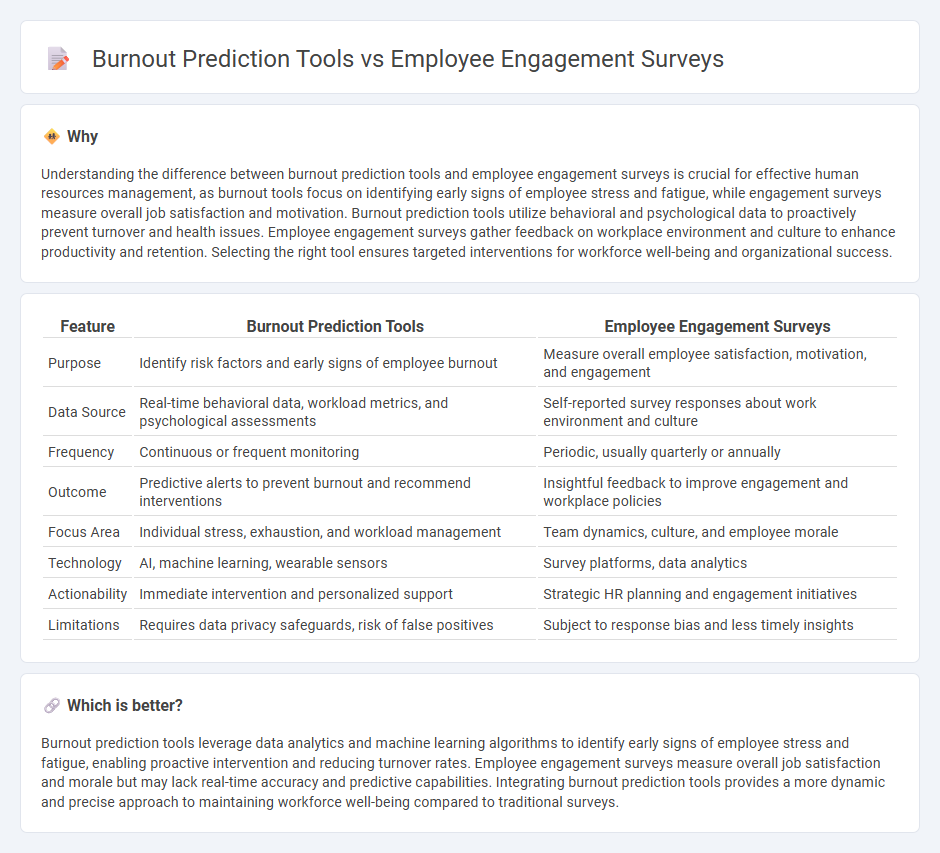
Burnout prediction tools utilize data analytics and behavioral metrics to identify early signs of employee stress and exhaustion, enabling proactive interventions. Employee engagement surveys gather subjective feedback to assess overall job satisfaction, motivation, and workplace climate, offering insights into morale and organizational culture. Explore how integrating these approaches can enhance workforce well-being and productivity management.
Why it is important
Understanding the difference between burnout prediction tools and employee engagement surveys is crucial for effective human resources management, as burnout tools focus on identifying early signs of employee stress and fatigue, while engagement surveys measure overall job satisfaction and motivation. Burnout prediction tools utilize behavioral and psychological data to proactively prevent turnover and health issues. Employee engagement surveys gather feedback on workplace environment and culture to enhance productivity and retention. Selecting the right tool ensures targeted interventions for workforce well-being and organizational success.
Comparison Table
| Feature | Burnout Prediction Tools | Employee Engagement Surveys |
|---|---|---|
| Purpose | Identify risk factors and early signs of employee burnout | Measure overall employee satisfaction, motivation, and engagement |
| Data Source | Real-time behavioral data, workload metrics, and psychological assessments | Self-reported survey responses about work environment and culture |
| Frequency | Continuous or frequent monitoring | Periodic, usually quarterly or annually |
| Outcome | Predictive alerts to prevent burnout and recommend interventions | Insightful feedback to improve engagement and workplace policies |
| Focus Area | Individual stress, exhaustion, and workload management | Team dynamics, culture, and employee morale |
| Technology | AI, machine learning, wearable sensors | Survey platforms, data analytics |
| Actionability | Immediate intervention and personalized support | Strategic HR planning and engagement initiatives |
| Limitations | Requires data privacy safeguards, risk of false positives | Subject to response bias and less timely insights |
Which is better?
Burnout prediction tools leverage data analytics and machine learning algorithms to identify early signs of employee stress and fatigue, enabling proactive intervention and reducing turnover rates. Employee engagement surveys measure overall job satisfaction and morale but may lack real-time accuracy and predictive capabilities. Integrating burnout prediction tools provides a more dynamic and precise approach to maintaining workforce well-being compared to traditional surveys.
Connection
Burnout prediction tools analyze data from employee engagement surveys to identify early signs of stress and disengagement, enabling HR teams to implement targeted interventions. These tools leverage metrics such as workload, job satisfaction, and emotional exhaustion collected through surveys to forecast burnout risk accurately. Integrating both methodologies enhances workforce well-being and reduces turnover by proactively addressing underlying issues.
Key Terms
**Employee Engagement Surveys:**
Employee engagement surveys measure job satisfaction, motivation, and commitment by gathering employee feedback on workplace culture and management effectiveness. These surveys provide actionable insights into employee morale and areas for improvement, helping organizations enhance productivity and reduce turnover. Discover how leveraging employee engagement surveys can transform your workplace environment and boost overall performance.
Job Satisfaction
Employee engagement surveys measure job satisfaction by assessing overall feelings of fulfillment, motivation, and workplace relationships, providing a comprehensive view of employee morale. Burnout prediction tools focus on early indicators such as emotional exhaustion and workload stress, offering predictive insights into potential declines in job satisfaction. Explore how integrating both methods can enhance workforce well-being and productivity.
Feedback Mechanisms
Employee engagement surveys traditionally capture broad sentiment and overall workplace satisfaction through structured feedback mechanisms, while burnout prediction tools utilize real-time data and behavioral indicators to identify early signs of stress and exhaustion. Engagement surveys rely on periodic self-reported responses, offering a snapshot that may miss critical stress signals, whereas burnout tools analyze continuous inputs such as work patterns, communication frequency, and physiological data for proactive intervention. Explore in-depth comparisons to optimize feedback strategies for enhancing employee wellbeing.
Source and External Links
Employee Engagement Surveys: Ultimate Guide - Offers a comprehensive approach to using surveys to measure employee satisfaction and engagement, with examples of effective questions to improve workplace culture.
Employee Engagement Surveys: The Questions to Ask & Why - Provides tips and templates for creating effective employee engagement surveys, focusing on themes like job satisfaction and career progression.
Employee Engagement Survey Questions - Includes a set of questions that form an "engagement index," measuring aspects like pride, recommendation, and motivation among employees.
 dowidth.com
dowidth.com